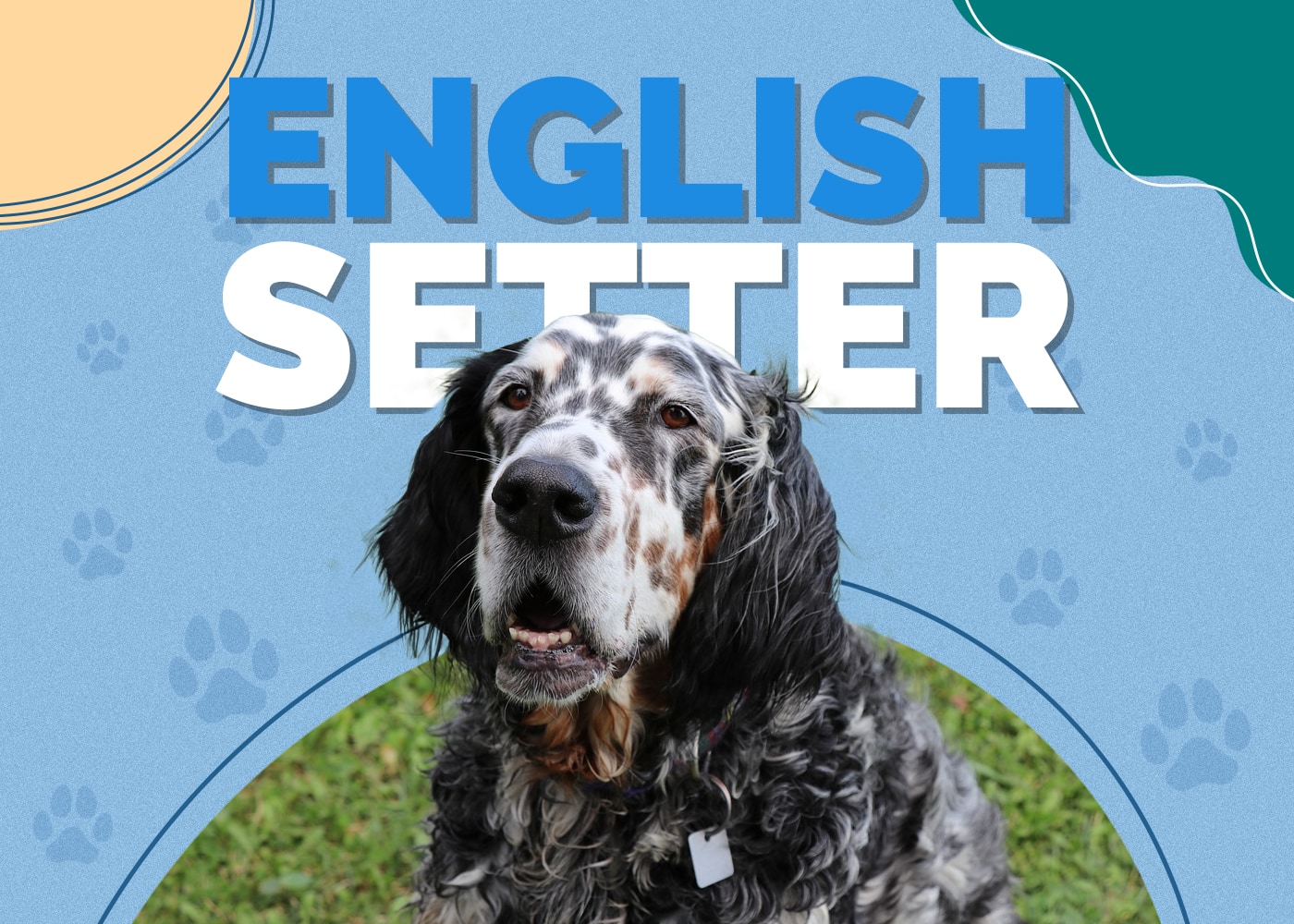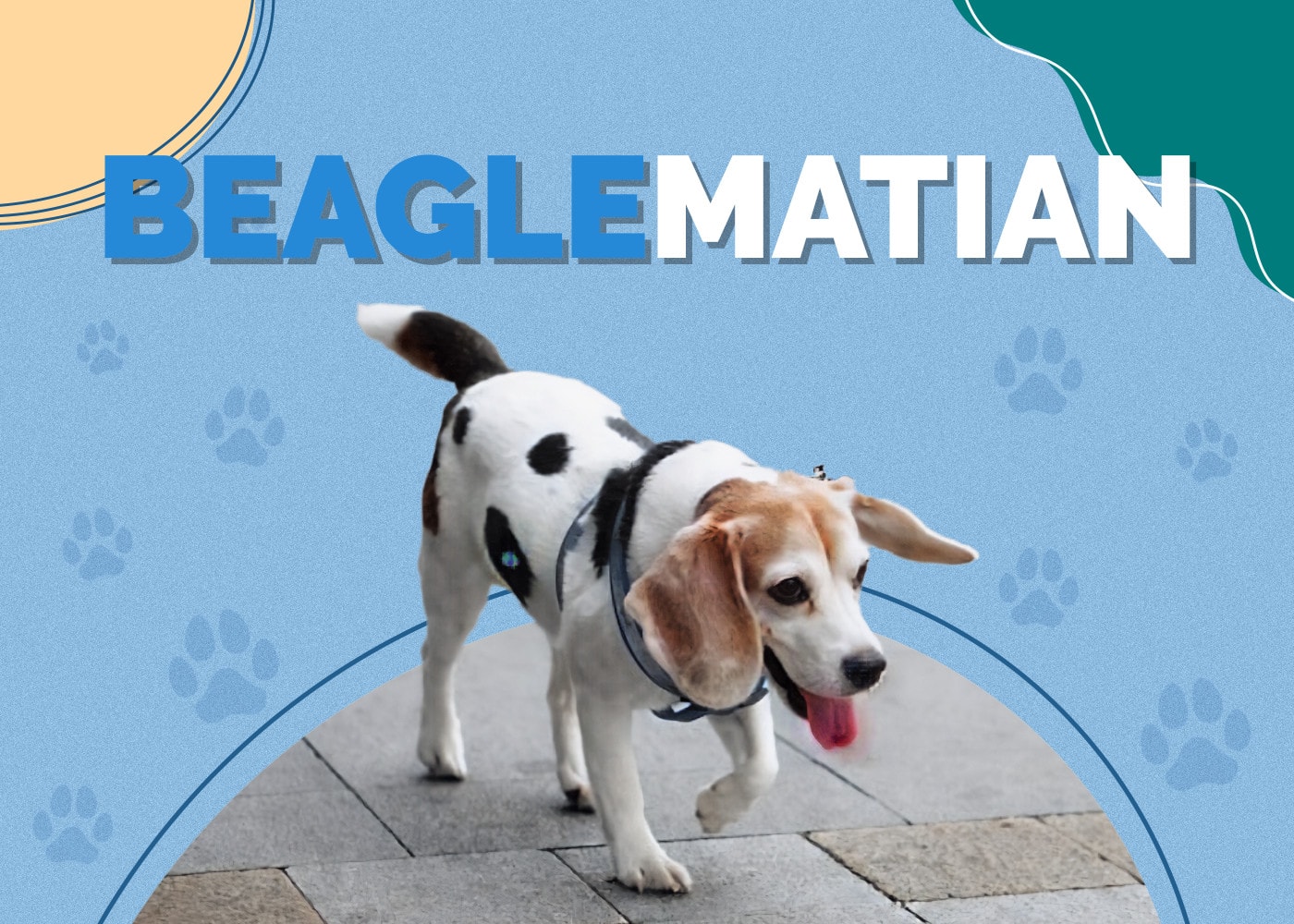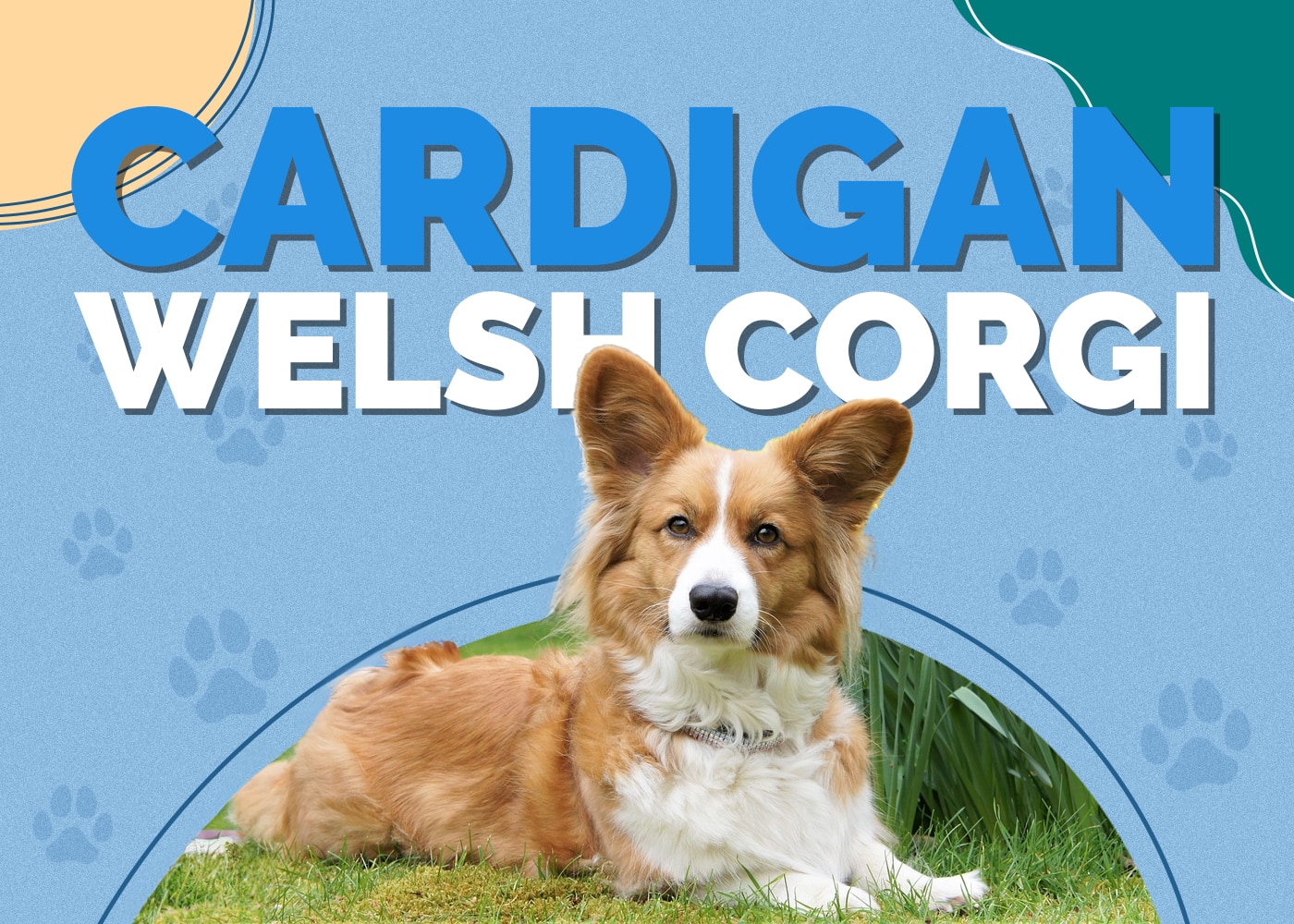Curly Coated Retriever | Dog Breed Info: Pictures, Traits & Facts

Updated on
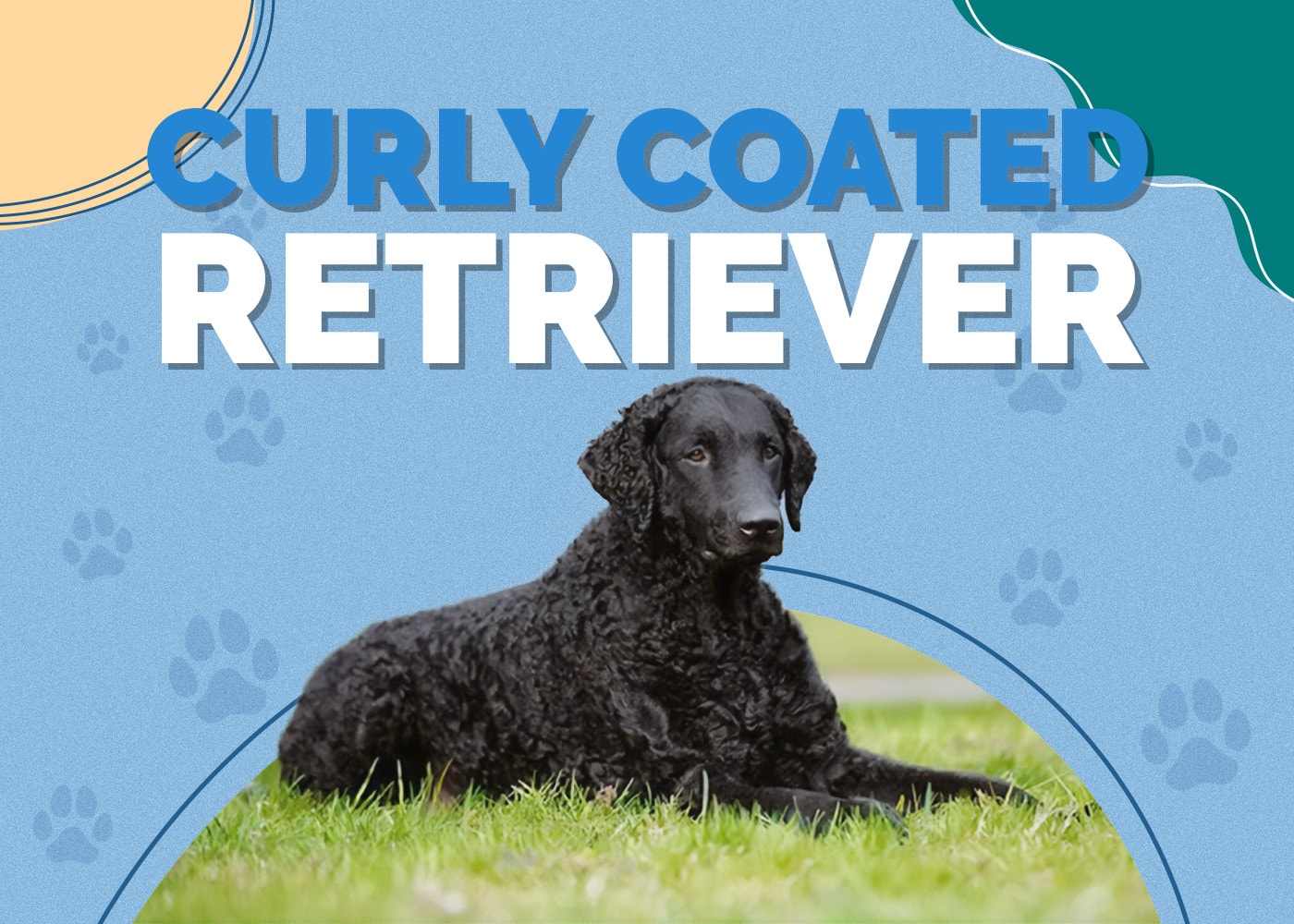
| Height: | 23 – 27 inches |
| Weight: | 60 – 95 pounds |
| Lifespan: | 10 – 12 years |
| Colors: | Black, brown |
| Suitable for: | Active families, hunting, companionship |
| Temperament: | Highly intelligent, confident, poised |
The Curly-Coated Retriever can also be called a Curly. They look like the more popular Labrador Retriever in many ways, with their coat having the most distinct difference. They have curly, waterproof fur in black or shades of brown. They also have longer, pointed tails.
The Curly-Coated Retriever is a large-breed dog with the heart to match. Sometimes they can seem aloof because of their inherent pride and poise. However, when given the opportunity to get to know someone, they warm reasonably quickly.
These pups are considered high-energy dogs but are otherwise regarded as low-maintenance pups with a versatile set of capabilities and a strong work ethic.
 Curly-Coated Retriever Puppies
Curly-Coated Retriever Puppies
Curly-Coated Retrievers are purebred dogs that are not extremely common or easy to find. They do make excellent pets, though. When you find a breeder, expect to be put on a waiting list for a while.
You want to find a breeder with a good reputation since they reliably breed their dogs in healthful conditions and with honesty concerning their pedigree and parentage. A breeder should always be willing to show you the parents’ papers. They should show you their certifications and proof of pedigree if they make claims about the puppy’s heritage. They should also allow you a tour around their breeding facility. Doing so helps prove that you support a breeder who treats their dogs properly and not as a puppy mill.
Curly-Coated Retrievers do have strong purebred lines. They are also a versatile dog with quite a few uses if you want a pup that works hard. The AKC classes them in the Sporting Group, so some dogs might not have a pedigree but their parents are renowned for their performance ability.
3 Little-Known Facts About the Curly-Coated Retriever
1. The Curly-Coated Retriever is one of the oldest Retriever breeds.
Retriever breeds are well-known and popular across the globe. They are newer to the sporting scene than Spaniels and Setters but have made a splash since the late 1700s and the arrival of rifles.
Curly-Coated Retrievers are one of the oldest Retriever breeds developed in England during the early 1800s. Although this is one of their claims to fame, we do not currently have a written record of their earliest existence, only educated assumptions.
The idea is that the Curly-Coated Retriever is a descendant of two breeds that have become extinct, making this claim slightly more difficult to validate. These include the Retrieving Setter and the English Water Spaniel.
Other dogs that played a part in the puzzle of this dog’s genetics are the Irish Water Spaniel and the St. John’s Dog. Poodles could also have been an addition to their genetics, to tighten their distinctive curly coats and give them extra airs and elegance.
By the late 1800s, Curlies were quite popular across England. Their unique look and elegant carriage made them a popular dog in dog shows and for nobility. Their ability as hunting dogs also made them common companions to hunters and sportsmen.
It was during this period in the late 19th century that Curlies were exported around the world and saw a quick rise in popularity. However, as more Retrievers entered the scene, their popularity was eclipsed quickly. These include Labrador Retrievers and Golden Retrievers.
Curly-Coated Retrievers have been entirely purebred since the early 1900s, when the dog clubs in England started to set more breed standards. Currently, the global population of Curlies is thought to be around 5,000, with fewer than 2,000 of these dogs in America.
2. Curlies tend to mature slowly.
Curly-Coated Retrievers tend to have more of a puppy nature about them for longer than you might imagine with a dog of such a reputation. What this can mean is that you should expect this already high-energy dog to be a bit erratic for a longer part of their life. Most puppies exhibit higher amounts of energy than their adult counterparts. If you are looking for an active dog, a Curly-Coated Retriever puppy will be an excellent fit.
Even if they take longer to mature, they are often described as having a wicked intelligence. Do not let their cute puppy ways deceive you. They need to be trained early on what appropriate behavior is, or they can get themselves into trouble.
3. Curly-Coated Retrievers do not have curly hair covering their entire body.
With a name like “curly-coated,” you would think that these Retrievers would have mounds of curly fur covering them from top to bottom, like the Poodle. However, the Curly-Coated Retriever has short fur that coils tightly and near their bodies. The central portion of their bodies, upper legs, ears, and tail all have this distinctive fur pattern. However, their faces and bottom part of their legs lose the curly edge and become straight.
What you end up with is a dog with the face of a Labrador Retriever and the coat of a Poodle. For this reason, when many people see a Curly-Coated Retriever, they believe them to be a crossbreed, mixed with a Lab and a Poodle. In reality, these dogs have a purebred heritage.

Temperament & Intelligence of the Curly-Coated Retriever 🧠
With their family, a Curly-Coated Retriever is charming, often acting like a gentleman among dogs. They are affectionate with their family even though they can be aloof around strangers. Socialize them with groups of different people from an early age so they know how to interact with those they are not familiar with.
These pups are known for having quite a determined personality. They know what they want, and with their incredible intelligence, they generally do not have an issue figuring out how to get it. Combine intelligence with their self-confidence, and you get a dog who feels on top of the world all the time.
Curly-Coated Retrievers have low attention spans and can get bored easily. They need someone to keep their attention and for their trainer to be just as determined as they are. They will be quite playful for much longer than some other breeds, which can sometimes make them more difficult to train.
Are These Dogs Good for Families? 🏡
Curly-Coated Retrievers are an excellent choice of dog for an active family. They are ever alert and always ready to play or show affection to the humans they love. They typically behave well around kids and often sympathize with them because they behave like puppies for so long.
If these dogs grow up with your kids, they will have a loyal companion for life who challenges them to stay active and curious. Around very young kids, their energy level and size can be intimidating. Make sure to teach both parties how to behave appropriately with each other.
Does This Breed Get Along With Other Pets? 🐶 😽
Curly-Coated Retrievers are typically easy-going canines that do not mind having other pets around. It can help to keep them with other dogs if you have difficulty managing their energy levels.
Since they can be a bit standoffish, it is best to socialize them from an early age at dog parks or on walks with other pups. If you bring a new dog into the home, allow them time to adapt and become accustomed to sharing their space with strangers.
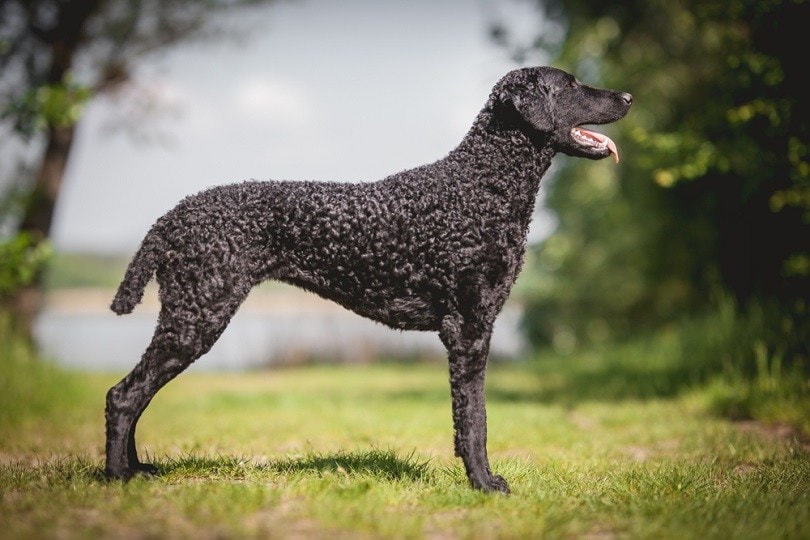
 Things to Know When Owning a Curly-Coated Retriever
Things to Know When Owning a Curly-Coated Retriever
Food & Diet Requirements 🦴
Curly-Coated Retrievers combine being a large-breed dog with a high level of energy and desire for activity. Together, it means that they have rather voracious appetites and need a premium diet to keep them healthy.
Feed your Curly between 3-4 cups of food each day. Monitor their weight to ensure that the food is being used properly. They often overeat if left to their own devices.
These dogs will eat almost anything left out or set in front of them, so do not ever free feed them. Instead, break their meals up into two or three segments throughout the day, taking the food away that they do not eat in one sitting. It is unlikely, though, that there will be any left.
Feeding them a diet meant for active dogs is better than choosing a generic dog food. These formulas will have higher levels of protein and fat to keep them going throughout the day.
Exercise 🐕
Since Curly-Coated Retrievers are a high-energy dog, it is not wise to bring these dogs into an apartment. They need plenty of time spent outside and doing active things.
These activities could include hiking, running, training in agility sports, or swimming. You can also take them out for several walks a day, but expect these to be longer than for some other breeds.
If you prefer to walk or run, try to hit at least 14 miles a week with them to keep them in shape and satisfy their craving for activity. About 90 minutes of consistent movement each day will also hit their target.
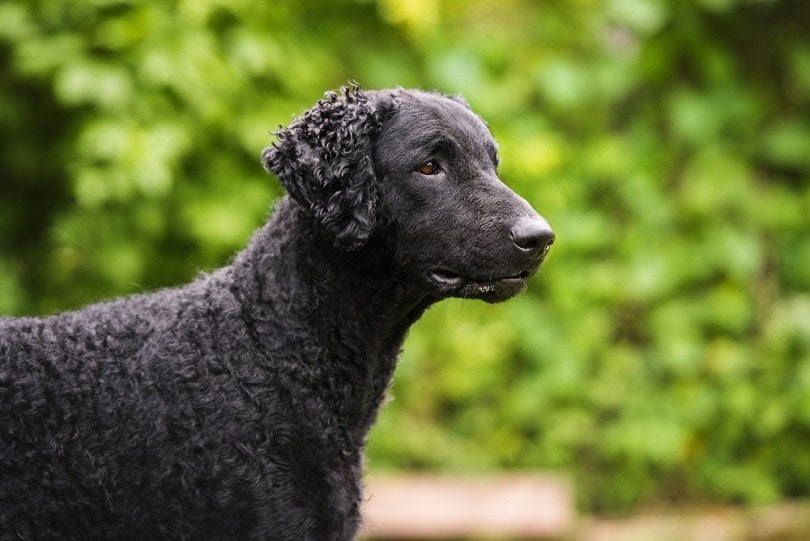
Training 🦮
Training Curly-Coated Retrievers can be a mixture of easy and emotionally demanding. This strange combination is because they are so smart, they can catch onto new ideas quickly. However, their attention spans are short and they get bored fast. Too much repetition results in them not caring anymore, and they stop listening.
To avoid this, try and engage them during every session. Make training something that they look forward to or incorporate into fun activities. You need to match their level of determination and keep at it to have a long-lasting effect.
Grooming ✂️
Grooming your Curly is one of the more convenient aspects of caring for them. They do not have an undercoat, so they don’t shed as much as other breeds. However, their coats tend to be oily, so they don’t make outstanding options for those who suffer from allergies.
They do not need grooming often, or their coat starts to become frizzy. Typically, they only need it during the spring and fall seasons as they begin to shed a bit more.
Otherwise, care for a Curly-Coated Retriever just as you would any other breed. Clip their nails when they grow out too long, and brush their teeth at least twice a week to avoid tartar build-up. Since they have semi-floppy ears, check them weekly and gently clean out any moisture and debris.
- See Also: 11 Best Dry Dog Shampoos
Health and Conditions ❤️
Although most Curlies are healthy dogs, issues can crop up. Continue to take them to their veterinary appointments consistently so you catch any problems as early as possible.
- Entropion
- Ectropion
- Distichiasis
- Persistent pupillary membrane
- Alopecia
- Bloat
- Glycogen storage disease
- Hip dysplasia
- Elbow dysplasia
- Cancer
 Male vs. Female
Male vs. Female
Males are slightly larger, averaging closer to 27 inches and 100 pounds, while females top out at around 25 inches and 85 pounds. There are no significant differences between the personalities of male and female Curly-Coated Retrievers.
 Final Thoughts: Curly-Coated Retriever
Final Thoughts: Curly-Coated Retriever
Curly-Coated Retrievers are excellent for a wide variety of people who have active hobbies or lifestyles. They make wonderful companion dogs and are good for hunters, sportsmen, or as a show dog. They do well with families and get along with kids.
These dogs have prominent personalities that greatly humanize them. They are determined and proud yet loving and affectionate. These are the kinds of dogs that you find yourself having full conversations with. If you are confident that you can meet their need for consistent activity, then they are sure to make excellent companion.
Featured Image Credit: otsphoto, Shutterstock
 Curly-Coated Retriever Puppies
Curly-Coated Retriever Puppies
 Things to Know When Owning a Curly-Coated Retriever
Things to Know When Owning a Curly-Coated Retriever Male vs. Female
Male vs. Female